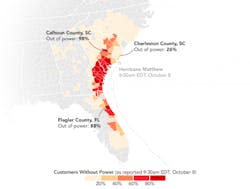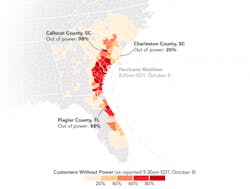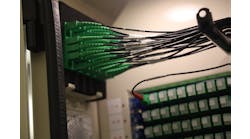Hurricane Matthew made a blunt case for microgrids last week as it toppled thousands of electric poles and wires across four states in a cascade that left millions without electricity, some even a week later.
Arriving about a month shy of the four-year anniversary of Superstorm Sandy, Matthew again reminded the U.S. why interconnected grids and storms can be a toxic pair.
Of the larger utilities, Florida Power & Light reported 1.2 million outages at the height of the storm. In the Carolinas, 1.36 million Duke Energy customers lost power as 60 transmission lines and 150 substations failed under the hurricane’s onslaught of wind and water. The company struggled through flood waters to repair damage. Georgia Power reported 341,000 outages.
“Hurricane Matthew, and similar storms in the past like Hurricane Sandy, show us that our grid is still vulnerable. And while smart grid technology can reduce and eliminate power outages, when superstorms hit, entire regions are still affected,” said David Chiesa, S&C Electric’s senior director of global business development.
During such storms, microgrids offer refuge as they electronically island from cascading destruction, basically shutting down their connection to the larger grid to protect themselves. The microgrid then activates its own distributed generators to serve customers within its footprint.
Princeton University became a poster child for microgrids during Superstorm Sandy as it kept the lights on for the campus, even as those all around it went dark. Since then, the Northeast has embarked on a campaign to build microgrids to serve shelters, hospitals, police and fire stations, water treatment plants, grocery stores and gas stations.
In fact, as the Southeast was struggling to restore power October 12 – with 360,000 customers still out six days after the hurricane – New York was accepting applications for the second stage of its $40 million NY Prize.
New York set up the program after Sandy to spur development of microgrids for communities and critical facilities. Other Northeast states, as well, began programs to encourage development of microgrids and other forms of distributed generation that use advanced controls and automation. In 2012, Sandy had knocked out power to 8.1 million customers, some for two weeks.
Wake up call?
Chris Clippinger, east region business development manager for SEL Engineering Services, foresees a similar ramp up in microgrid activity now ahead for the Southeast.
“With storms such as Hurricane Matthew there is little utilities can do to prepare. What the microgrid technology does afford is faster return to service, which can be quite critical to local emergency response and health care,” Clippinger said. “Hurricane Sandy was a good example of a ‘wake-up’ call, and the significant investment the northern utilities are making to make the grid more resilient. I would expect to see similar initiatives happen in the Southeast now based on the devastation wrought by Hurricane Matthew.”
Clark Wiedetz, microgrid director for Siemens Energy Management, noted that Sandy – and the Northeast’s subsequent actions – offer a framework for the Southeast states to consider.
“We have a model to look at. We’re not starting from scratch,” he said.
At the same time, he pointed out that the energy economics are different in the Southeast than they are in the Northeast. Electricity prices are generally higher in the Northeast, so it may be easier to make an economic case for microgrids in states like New York, New Jersey and Connecticut, than in Florida, Georgia and the Carolinas.
Credit: NASA
Wiedetz sees need for “a huddle up of utilities, cities and states to jointly evaluate where microgrids make sense for the Southeast.”
Likely beneficiaries include coastal hospitals, research labs and city and state critical infrastructure. The evaluation will need to consider not just the cost of a microgrid, but also the cost of power outages to business and government – particularly since severe storms seem to be happening more and more frequently, he said.
Several sources we spoke to praised southeast utilities for their massive restoration effort with thousands of workers brought in from out of state to help. In some cases they were better prepared for this storm than others because of new automation equipment installed that makes restoration quicker.
What if?
“You must ask the question, what would the impact of a superstorm be without distributed automation technology incorporated into the grid?” S&C’s Chiesa said.
S&C has installed distributed automation technology in Florida, which makes for quicker recovery, and speeds restoration to many customers. This allowed the local utility’s linemen to concentrate and focus on the areas that needed the most attention, he said.
“At S&C, we believe new, modern grid technology is essential to improve response to extreme weather,” he said. “With self-healing systems or energy storage applied in microgrid-type applications, utilities can harden their electrical infrastructure, create back-up power sources and improve reliability for their customers.”
Bob Stojanovic, ABB’s director of microgrids for North America, noted that “microgrids are one of many tools for dealing” with wide spread power outages from natural disasters.
“The ‘superstorms’ of the last decade have highlighted, in painful and expensive ways, the need to protect consumers from the devastation caused by natural disasters. In addition, the technology needed to make microgrids feasible for everyday use has reached a point where it is commercially viable and available,” he said. “We look forward to a future where local regulators and utilities can find a way to implement utility owned microgrids for the greater public good as part of a larger plan to deal with these types of events.”
With U.S. headquarters in North Carolina, ABB had a closeup of the destruction from the hurricane.
“We have first-hand knowledge of the suffering and hardship that this disaster has brought to the people in Florida and the Carolinas. We are extremely grateful for the first responders and other essential personnel that have been working hard to get the power back on in the affected areas,” Stojanovic added.
For the short-term, utilities were continuing to restore power to customers as of Thursday with about 164,000 still in the dark. Long term, it remains to be seen how the southeastern power industry responds. Even before the hurricane, Duke Energy was already developing demonstration microgrids, working with several private partners.
“It’s important to accelerate the replacement of ‘old grid’ technology for smart grid technology,” S&C’s Chiesa said. “We need to foster a regulatory environment that allows investor-owned utilities to make needed investments in grid modernization that can improve power reliability. That is essential to increasing adoption of modern grid technologies and ensuring our power systems can better withstand severe weather.”
Track news about microgrids by subscribing to the free Microgrid Knowledge newsletter.










